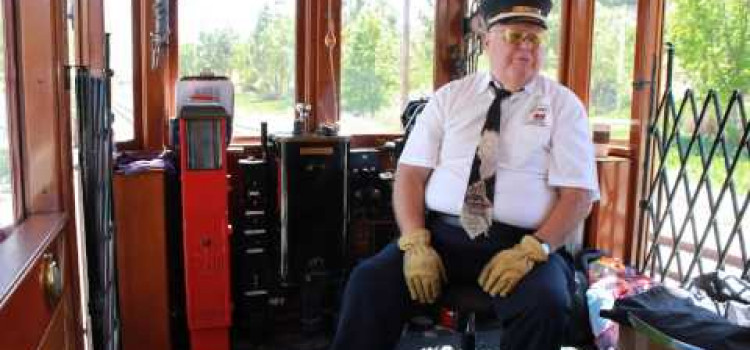

By Ivan Adame
For over a decade, the Red Car trolley system has served as a symbol of the Port of Los Angeles’ history and a tourist attraction. However, new construction may mean that the trolleys are just getting in the way, and its days may be numbered.
During a meeting on March 19, chief harbor engineer Tony Gioiello announced that the Red Car would be suspended for 18 months, due to the realignment of Sampson Way, the road that connects commuters to the Ports O’Call waterfront village. Since the new road will go over the existing track, with no plans to rebuild it, the beloved Red Car may be disappearing forever.
The red car is expected to transport its last passengers at the Lobster Festival late in September.
“The Red Car line bisects the Sampson Way project, Downtown Plaza project and skirts along the Ports O’ Call parking lot project,” said Gioiello. “The roadway project does allow however for a future rail line consistent with the rail line feasibility report.”
Board commissioners David Arian and Anthony Pirozzi, Jr. questioned why port engineers did not show any alternative plans for a rebuilt Sampson Way with rail tracks alongside it during the presentation. The project’s price tag starts at $40 million, just to replace the current 1.5 mile track, along with new safety modifications which were not required in 2003, when the Red Car line was brought back to life.
“You know the engineering philosophy: you’ve got to do it now, otherwise you won’t do it,” said Pirozzi. “I don’t think later is going to be an option. We need to decide and be straight with the public as to what we think is affordable and what is feasible.”
The board balked the high cost of the current plan, with Commissioner Patricia Castellanos calling it “prohibitive.”
Two members of the Northwest San Pedro Neighborhood Council in attendance expressed concerns about the future of the red car.
“The Red Car is your icon and it represents the port in much of your literature,” said Pat Nave, who is the city attorney liaison for the neighborhood council. “Your cost per rider is a little more than your costs per visitor for the aquarium is and you could cut it in half with a couple of modifications.”
“You have a gem here,” said Bob Bryant, who is also one of the conductors of the Red Car. “This is a part of San Pedro, and from what I’ve been listening to, you’re not marketing the program, you’re not funding the program, and you’re [suddenly] talking about putting up a $40 million program? We only have $100 million [to spend] in the next ten years. This is ridiculous.”
The Red Car system was part of Pacific Electric Railway, which in the 1920s was the nation’s largest interurban electric railway system, connecting cities across the Los Angeles, Orange, San Bernardino, and Riverside counties. It operated from the turn of the century until the early 1960s, when the last remnant of the system, the Long Beach line, was dismantled.
In 1999, the port announced that an old coal line would be retrofitted to carry two replica Red Cars, the 500 and the 501, built by craftsmen in Seattle and then in Wilmington. The public was invited to witness the progress of its construction during the weekends. Another trolley, designated 1058, was purchased from a private owner and restored to its original rail form as it had been fitted with rubber tires.
“I felt that the only way to make it any way viable was to have the Pacific-Electric link to make this a regional attraction,” said Bob Henry, who was the project manager. “We tried to make the cars as original as possible.”
When the four-year project was completed in 2003, San Pedro residents and visitors met the trolleys with great celebration. It was the first time in more than 40 years a Red Car had run on a historic Los Angeles route.
The now 12-year-old Red Car line, which runs through four stations across 1.5 miles, was once indicative of the potential of a revived waterfront at the Port of Los Angeles. However, factors like reduced activity of cruise ships have limited operation from two cars to just one. Also, the car now operates only three days a week instead of four.
There have been plans to extend the line to Cabrillo Beach and Wilmington, as well as the construction of a Red Car museum. But today, some have dubbed the Red Car line a “railway to nowhere,” as Commissioner Anthony Pirozzi, Jr. mentioned during the March meeting.
Gioiello recommended that the free buses provided by the local business improvement district, which are modeled to look like Red Cars, be used as a replacement for the trolley service. But trolley operators bristled at the idea.
“The Red Car is a museum on wheels,” said Bryant, the trolley operator. “A million people did not come to San Pedro to go from a non-place to a non-place. They came for what this trolley represented. So, taking this trolley out of service and to put a bus back in its place, one that looks like a trolley, is not what the community wants. How do you replace a Rembrandt?”
For now, the future of the Red Car is murky. “We’re in the dark,” said Jay Radinski, another trolley operator. “I’m not going to hazard a guess.”
In the meantime, Bryant and others are planning meetings with port officials to come up with new ideas to cut costs and ensure the Red Car will return after the road construction. There is a Facebook page titled Save The Red Car, along with a petition on change.org asking LA Mayor Eric Garcetti others to act.
